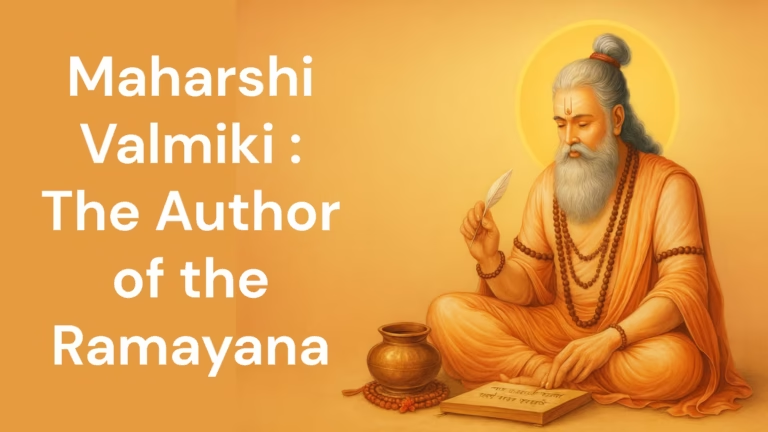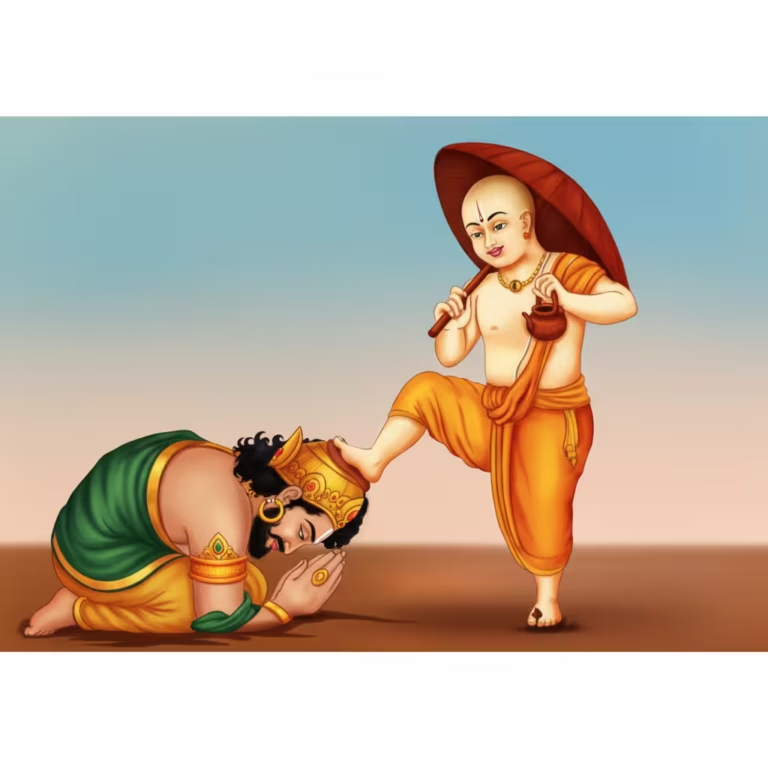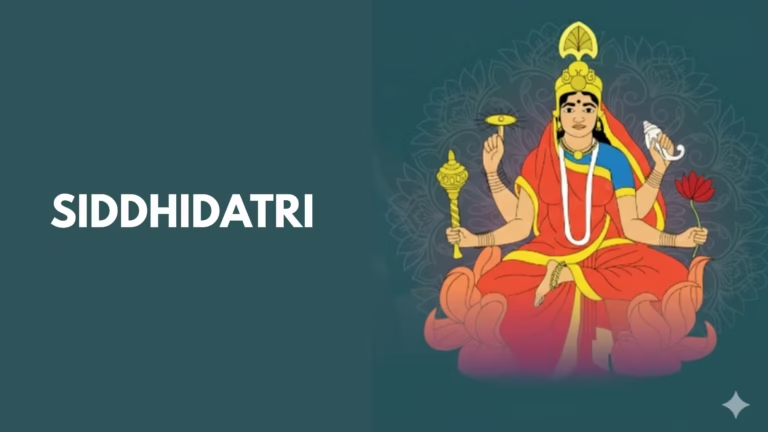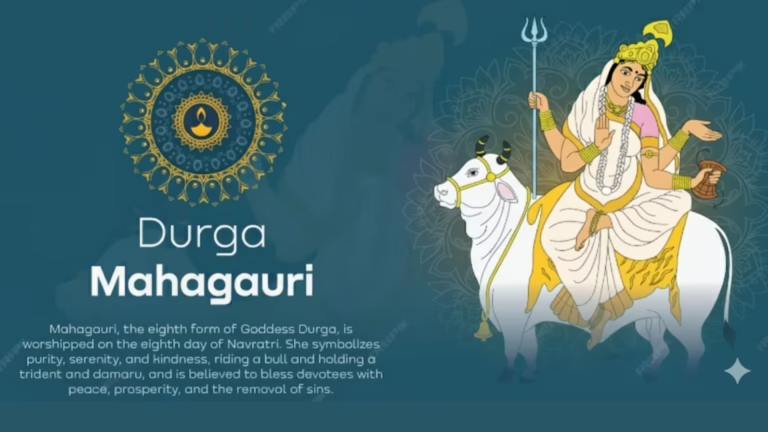As the fourth form of the Navadurga, Maa Kushmanda embodies the creative thrust of Shakti—the initiator of creation, the nurturer of order, and the dispeller of fear. Within the Shakta tradition, the expansion of the Primordial Energy (Adi‑Shakti) is presented across the Purāṇic corpus—especially the Markandeya Purana (Devi‑Mahatmya), the Devi‑Bhagavata Purana, and other Shakti‑centric scriptures—where each divine form signifies a particular cosmic function. Remembered in tradition as the One who dwells in the solar sphere, depicted with eight or ten arms, and mounted upon a lion, Maa Kushmanda is revered as a guardian of dharma and a protectress of seekers.
This life‑charit compiles, from a Purāṇa‑based perspective, the etymology, origin, iconography, divine acts (lila), worship discipline, and fruits of sadhana, so that readers gain an account that is faithful to scripture, fact‑oriented, and practically illuminating.
Name, Etymology, and Symbolic Import
A well‑known traditional etymology for “Kushmanda” parses the word into ku (little), ushma (warmth/energy), and anda (the cosmic egg), pointing to the Goddess as the inaugurator of creation—the One from whom warmth and energy expand to shape the cosmic egg. The core Purāṇic insight is that Adi‑Shakti initiates and sustains the cyclic rhythms of creation (srishti), preservation (sthiti), and withdrawal (samhara). The form of Kushmanda provides a contemplative symbol for this initiating power.
Two principal layers of symbolism arise:
- Solar Association: The form is associated with radiance, life‑energy, and sustained action—like the sun that animates worldly activity.
- Cosmic‑Egg Imagery: The metaphor of the brahmanda (cosmic egg) evokes the philosophical vision of creation’s emergence from the One—resonant with Shakta Vedanta’s teaching of the One‑without‑a‑second unfolding into manifold existence.
Note: Traditional etymologies are found in Purāṇic poetry, commentaries, and lineage expositions. Their intent is devotional and contemplative—to remember the Goddess as the initiator of creation.
Origin‑View: Shakti‑Tattva and the Impulse to Create
Purāṇa tradition identifies the Primordial Shakti as the Mahāmāyā of Parabrahman—the power through which devas arise, cosmic order moves, and adharma is subdued. In the Devi‑Mahatmya, the Goddess manifests multiple forms in response to the praises of the gods, establishing dharma by destroying demonic forces and re‑harmonizing the worlds. The Devi‑Bhagavata Purana further elaborates the vast expanse of Adi‑Shakti, stages of creation, and foundational modes of worship.
Within this larger scriptural horizon, the concept of Kushmanda is understood as the impelling energy at the dawn of creation—the integrator of radiance and action and the substratum for a karma‑guided world‑order. This form holds a dynamic balance of heroic force and compassion: destroying unrighteous tendencies while protecting the path of dharma.
Iconography: Arms, Emblems, Vehicle, and Radiance
Purāṇic descriptions and Shakta hymns remember Maa Kushmanda as a resplendent, many‑armed form, bearing diverse emblems and associated with leonine valor. Key iconographic notes include:
- Arms: Typically eight or ten arms, each signifying a facet of divine power and stewardship.
- Emblems/Weapons:
- Khadga (sword), Trishula (trident), Gada (mace), Chakra (discus), Dhanush‑Bana (bow‑arrow)—symbolizing the subjugation of ignorance and the protection of righteousness.
- Mala (rosary)—indicative of contemplation and mantra‑japa.
- Ghata/Kalasha (pot)—sign of nourishment, sustenance, and blessing.
- Kamandalu (water‑jar)—discipline, purity, and the flow of sacred life.
- Varada/Abhaya Mudra—boons and fearlessness for devotees.
- Vehicle: The lion, emblem of unwavering courage, fearlessness, and dharma‑protection.
- Radiance: A solar halo often surrounds the form, denoting inexhaustible life‑energy and the source of purposeful action.
Each aspect of the iconography can be contemplated with the framework of the Goddess’s five cosmic acts: creation, preservation, withdrawal, concealment (tirobhava), and grace (anugraha).
Divine Acts (Lila) and the Protection of Dharma
Purāṇas repeatedly affirm that whenever dharmic order is impeded, Shakti manifests appropriate forms to dissolve obstacles and re‑establish balance. As Kushmanda, emphasis falls not only on the vanquishing of unrighteousness but also on the ignition of consciousness, the sustaining of life‑processes, and the installation of dharmic policy in human communities.
The poetic cadence of the Devi‑Mahatmya alternates between fierce manifestations that subdue demonic forces and devotional remembrances that center the Goddess as the benevolent ground of peace. Within this tapestry, Kushmanda signifies valor braided with serenity—radiance guided by compassion for the welfare of the world.
Worship Discipline (Shastric Basis)
In the Shakta tradition, worship rests upon mantra, meditation (dhyana), hymn‑recitation (stotra‑patha), and ethical purity of conduct. In the Navadurga sequence, Maa Kushmanda is honored on the fourth day of Navaratri. The scripturally consonant elements are:
- Purity and Resolve: Truthfulness, sattvic diet, disciplined conduct, and a firm resolve to worship the Goddess.
- Scriptural Recitation: Reading/chanting from the Devi‑Mahatmya (Durga‑Saptashati tradition), along with Shakta hymns and meditative verses, as instructed in one’s lineage.
- Mantra‑Japa: Seed‑mantras and Chandi/Chamunda mantras are practiced in Shakta communities; however, method and count must be received from a competent guru.
- Invocation, Offering, and Arati: Scripturally grounded invocations, offerings according to capacity, and peace‑invocations—inner purity is paramount.
Scriptural teaching emphasizes that purity of conduct, truth, compassion, and dharma constitute the essence of worship; external rites bear fruit only when inner sadhana is firm.
Fruits of Sadhana (Shastric Perspective)
As tradition presents it, the worship of Maa Kushmanda bears fruits that shape the devotee’s inner life and social outlook:
- Life‑Energy and Radiance: Dissolution of doubt, fear, and lethargy; awakening of sustained, purposeful action.
- Courage with Discernment: Stability in adversity and dharma‑aligned decision‑making.
- Obstacle‑Pacification: Calming of inner and outer impediments—anger, pride, negligence, and apathy.
- Orientation to Service: Moving beyond personal gain toward lokasangraha—the welfare of society.
Tradition also cautions that results endure only with steady practice, self‑restraint, and obedience to the guru’s guidance.
Place within the Navadurga Sequence
The nine worshipful forms of Shakti guide a seeker progressively through purification, austerity, valor, awakening of creative consciousness, maternal compassion, heroic vigor, illuminative knowledge, harmonization of powers, and integrality. In this sequence, Kushmanda (fourth) is the spark of creative consciousness and karma‑energy—the installation of resolution (sankalpa‑shakti) within the aspirant’s life.
Solar Imagery and Philosophical Meaning
Remembered as the Dweller in the Solar Sphere, Maa Kushmanda symbolizes the primordial source of life‑energy. As the sun nurtures worldly enterprise, so does the Goddess’s radiance nurture the moral‑spiritual vigor of communities. Here radiance is not merely physical light; it is the inner luminosity of dharma, knowledge, and discernment.
Dharma‑Ethic and the Kushmanda Principle
The Purāṇic conclusion is that the aim of Shakti‑worship is not personal accomplishment alone but the installation of dharma‑policy in life. The Kushmanda principle sensitizes seekers on three fronts:
- Self‑Governance: Mastery over impulses and tempering of attachment.
- Self‑Strength: Diligence, discipline, and intelligent stewardship of time—what tradition calls karma‑energy.
- Social Service: Practicing justice, compassion, and truth within family, workplace, and society.
Through this triple discipline, Shakti‑worship becomes a life‑plan—a concert of devotion (bhakti), knowledge (jnana), and action (karma).
What Not to Do in Purāṇa‑Aligned Worship
- Unscriptural Methods: Avoid rites or mantras outside authorized tradition.
- Showiness: Prefer cleanliness and sincere resolve over ostentation.
- Unverified Claims: Do not treat folk assertions as decisive without scriptural testimony.
Local Traditions through a Scriptural Lens
Many regional customs surround Kushmanda worship—particular offerings, colors, or flowers. The Purāṇic priority, however, is mantra‑recitation, upright conduct, and adherence to dharma. Adopt local observances while maintaining scriptural priority and the guidance of one’s guru.
Frequently Asked Questions (FAQ)
1) Is Kushmanda mentioned in the Purāṇas?
Shakta doctrine is richly laid out in the Devi‑Mahatmya and the Devi‑Bhagavata Purana; the Navadurga current of worship flows from this scriptural matrix and received tradition. Kushmanda is remembered within this worshipful stream as a contemplative form of the Goddess.
2) Is Kushmanda only a fierce, destructive form?
No. This form is both creative and sustaining—fierceness is for dissolving demonic tendencies; compassion is for protecting devotees.
3) Is there a universally fixed mantra?
Mantra‑practice must be received from a competent guru. Scriptural recitation—especially the Devi‑Mahatmya—is a safe and widely practiced path.
4) Are the number of arms, emblems, and the vehicle fixed?
Purāṇic poetry and iconographic traditions present varied counts and emphases. The intent is to convey the functional spectrum of the Goddess, not a rigid numerical fixity.
Teaching Message: Awakening Inner Radiance
The Kushmanda principle teaches that inner radiance—courage, restraint, diligence, and truthfulness—is the basis of a meaningful life. The essence of Shakti‑worship is to discipline the mind under dharma and to engage tirelessly in service of the world.
Maa Kushmanda thus channels into the seeker a continuous current of creative consciousness and karmic energy. The overarching Purāṇic message is that Shakti‑worship makes a person fearless, patient, wise, and public‑spirited. Its core lies in a pure heart, scriptural recitation, and obedience to the guru—the path that yields lasting peace and purpose.
Scriptural Orientation (Select)
- Markandeya Purana (Devi‑Mahatmya/Chandi) – for theology of Shakti’s manifestations and dharma‑restoration.
- Devi‑Bhagavata Purana – for Adi‑Shakti’s cosmic scope, creation‑sequence, and modes of worship.
- Traditional Shakta commentaries and lineage teachings on Navadurga devotion.



